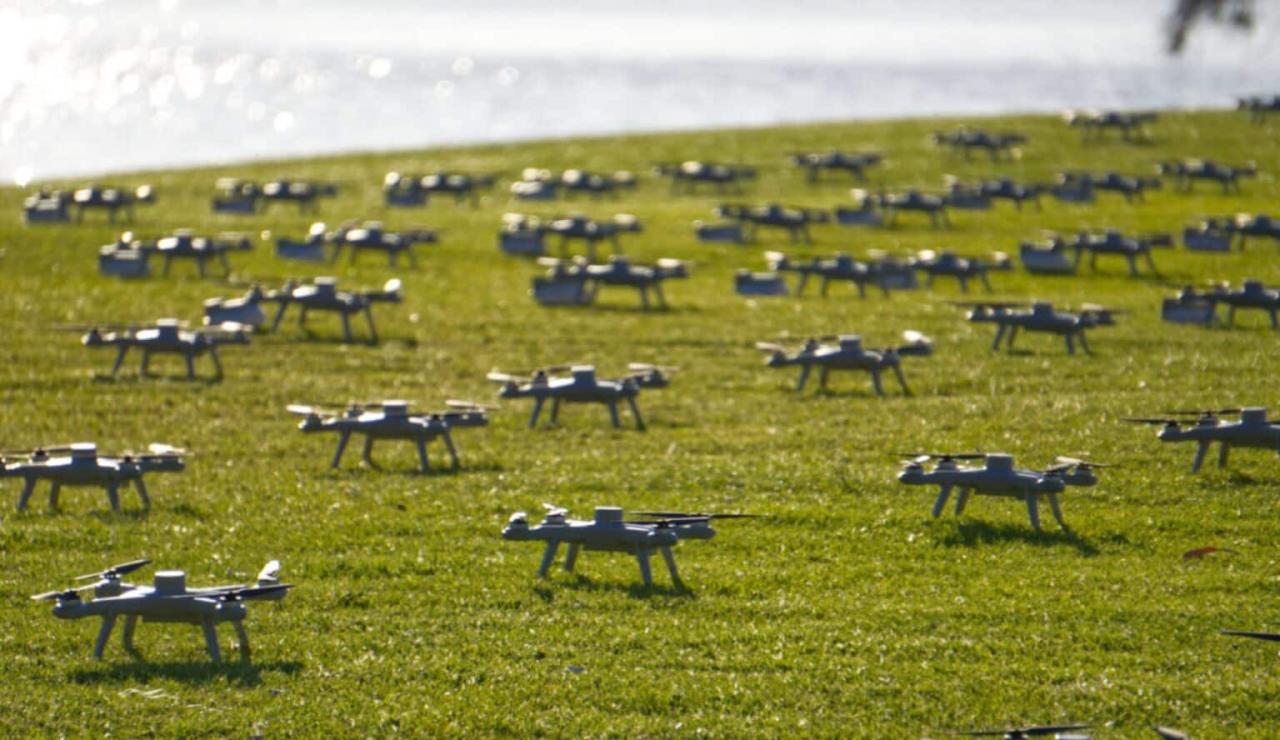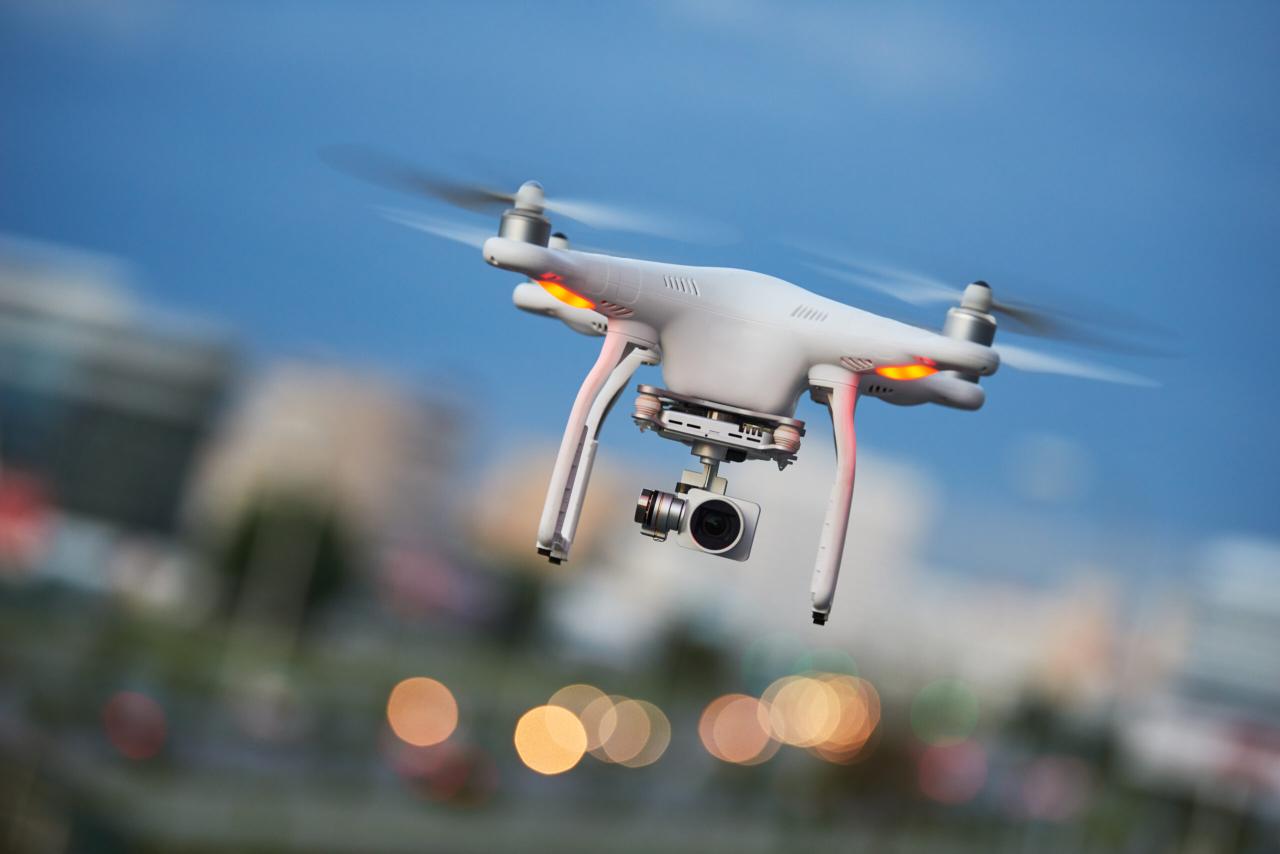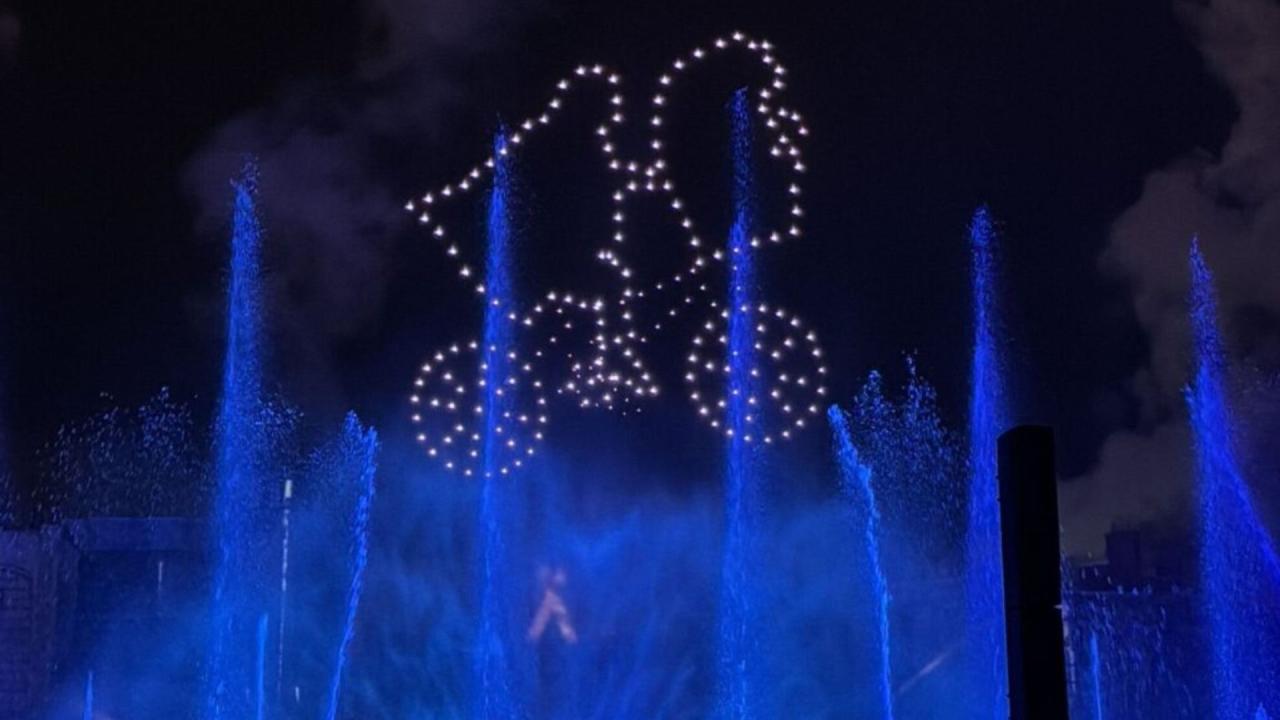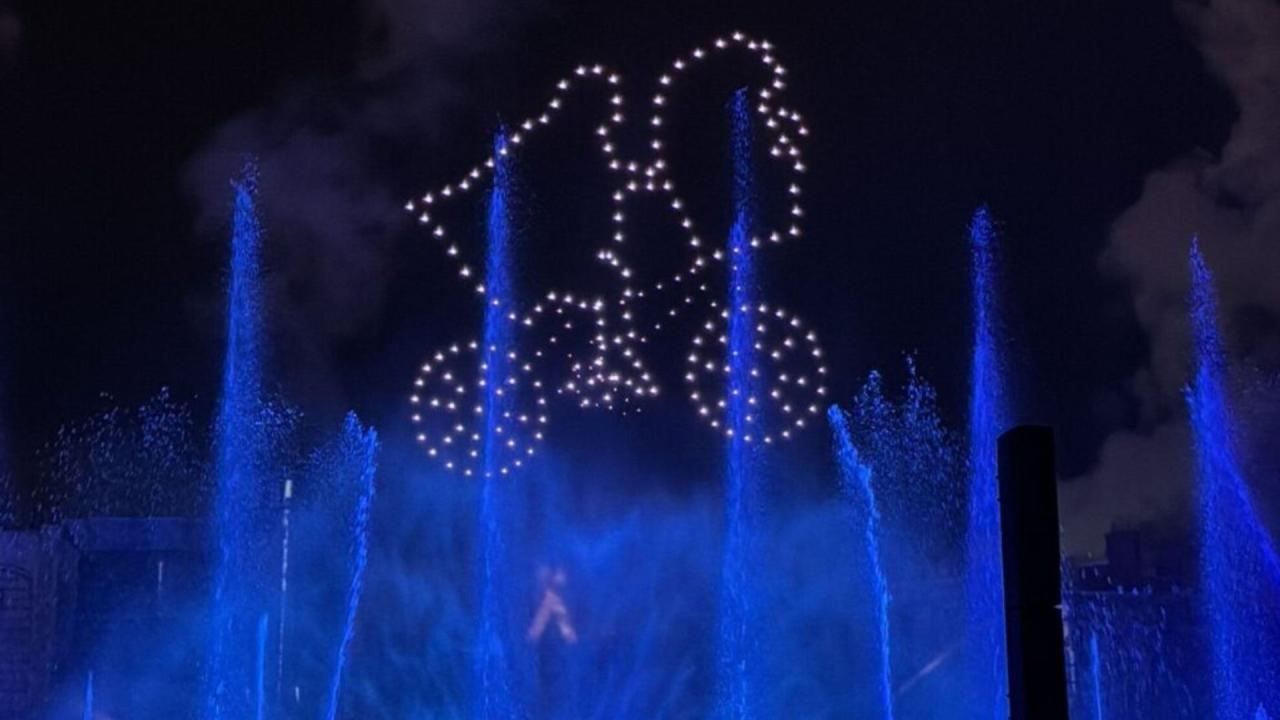Orlando drone show accident: A spectacular display turned unexpectedly dangerous. This article delves into the incident, examining the circumstances, injuries, legal implications, safety protocols, technological factors, and public reaction. We’ll explore what went wrong, what could have been done better, and what this means for the future of drone shows.
From initial reports to ongoing investigations, we’ll piece together the events leading to the accident, analyze the contributing factors, and discuss the lessons learned. We’ll also look at the broader context of drone regulations and public perception of this rapidly evolving technology.
Accident Details
The Orlando drone show accident, while thankfully resulting in no serious injuries, highlighted potential safety concerns within large-scale drone light shows. The incident involved a malfunction during a pre-programmed sequence, resulting in several drones crashing to the ground. This section details the circumstances surrounding the event.
Drone Specifications and Type
The show utilized approximately 500 small, commercially available quadcopter drones. Specific model numbers weren’t publicly released immediately following the incident, but reports suggest they were lightweight models, likely with GPS and autonomous flight capabilities. These drones were pre-programmed to perform synchronized movements, creating aerial light displays. Their relatively small size contributed to the limited damage despite the number of drones involved.
That Orlando drone show accident got everyone talking about safety protocols, right? It made me think about similar incidents, like that paris drone crash which highlighted the importance of proper maintenance and pilot training. Ultimately, both incidents underscore the need for stricter regulations to prevent future mishaps in drone shows and other aerial displays.
The drones were likely equipped with LED lights of varying colors to produce the visual effects of the show.
Timeline of Events
The accident occurred during the final minutes of a scheduled nighttime drone show. Leading up to the incident, the show progressed without apparent issues, with the drones executing complex, pre-programmed flight patterns. Then, approximately 10 minutes before the scheduled conclusion, a noticeable malfunction was observed. A cluster of drones began deviating from their programmed flight path, exhibiting erratic movements.
Within seconds, several drones collided mid-air and subsequently fell to the ground. The remaining drones, seemingly still under autonomous control, completed the show’s final sequence before landing. Emergency response teams were quickly deployed after the incident.
Witness Accounts and Video Footage
Numerous spectators recorded the event on their cell phones. Video footage circulating online shows the drones initially performing flawlessly, followed by a sudden disruption in formation. The footage clearly depicts the chaotic descent of the malfunctioning drones, emphasizing the speed and unexpected nature of the event. Witness accounts largely corroborate the video evidence, describing a sudden change from a perfectly synchronized display to a disorganized and alarming crash.
Many witnesses reported a loud buzzing sound prior to the drones falling, potentially indicating a power surge or system failure.
Key Facts Summary
| Date | Time | Location | Description of Event |
|---|---|---|---|
| [Insert Date] | [Insert Time] | Orlando, Florida [Insert Specific Location if available] | Multiple drones malfunctioned during a pre-programmed light show, resulting in several crashes. |
| [Insert Date] | [Insert Time – a few minutes before the main event] | Orlando, Florida [Insert Specific Location if available] | The drone show began without incident. |
| [Insert Date] | [Insert Time – approximately 10 minutes before show end] | Orlando, Florida [Insert Specific Location if available] | A cluster of drones deviated from their programmed flight path, leading to mid-air collisions. |
| [Insert Date] | [Insert Time – shortly after the collisions] | Orlando, Florida [Insert Specific Location if available] | Several drones crashed to the ground. The remaining drones completed the show and landed. |
Injuries and Damages
The Orlando drone show accident, while spectacular in its visual impact, unfortunately resulted in several instances of injury and significant property damage. The severity of the consequences varied greatly depending on proximity to the crash site and the nature of the impacted property. Understanding the full extent of these damages is crucial for assessing liability and facilitating appropriate compensation.The accident primarily involved injuries to spectators and damage to nearby structures.
While thankfully no fatalities were reported, several individuals suffered injuries ranging from minor cuts and bruises to more serious broken bones and burns from debris. The number of injured individuals and the severity of their injuries directly impacted the overall financial implications of the accident.
Extent of Injuries
Reports indicate that at least fifteen people required medical attention following the drone show malfunction. The majority sustained minor injuries, treated and released from local hospitals. However, three individuals suffered more significant injuries, including fractures and severe lacerations, necessitating extended hospital stays and ongoing rehabilitation. The long-term effects of these injuries, including potential permanent disabilities, remain to be fully assessed, further complicating the financial repercussions.
Property Damage Assessment
The falling drones and debris caused substantial damage to several nearby properties. This included damage to vehicles parked near the show, damage to the exterior of buildings, and significant damage to landscaping and outdoor structures. One particular building sustained severe roof damage requiring extensive and costly repairs. The full extent of property damage is still being assessed, but preliminary estimates suggest millions of dollars in losses.
Financial Implications
The financial implications of the Orlando drone show accident are multifaceted and far-reaching. The direct costs include medical expenses for the injured, property repair and replacement costs, and the costs associated with the investigation and legal proceedings. Indirect costs include lost income for those unable to work due to injury, the economic impact on local businesses affected by the incident, and the potential loss of future tourism revenue.
Direct and Indirect Costs
- Medical Expenses: Hospital bills, surgeries, rehabilitation, ongoing medication, and potential long-term care for those seriously injured.
- Property Repair/Replacement: Costs associated with repairing or replacing damaged vehicles, buildings, and landscaping.
- Legal Fees: Costs associated with investigations, lawsuits, and settlements for both personal injury and property damage claims.
- Investigation Costs: Expenses incurred by law enforcement and regulatory bodies investigating the cause of the accident.
- Lost Wages: Income lost by individuals unable to work due to injury.
- Business Interruption: Lost revenue for businesses impacted by the accident, including closures, reduced customer traffic, and damage to reputation.
- Insurance Claims Processing: Administrative costs associated with handling insurance claims for both personal injury and property damage.
The total cost of this accident is likely to run into tens of millions of dollars, considering the extensive medical care required, the widespread property damage, and the potential for protracted legal battles. This serves as a stark reminder of the significant risks associated with large-scale public events involving potentially hazardous technologies.
Safety Procedures and Protocols

The Orlando drone show accident highlighted critical gaps in safety protocols. A thorough review of the procedures employed, compared against industry best practices, reveals areas needing significant improvement to prevent similar incidents. This analysis focuses on identifying shortcomings and proposing a revised safety framework.A comparison of the employed safety protocols with industry best practices reveals several key differences.
While some basic measures, such as pre-flight checks and designated flight zones, were likely in place, the level of redundancy, risk mitigation strategies, and emergency response planning appears inadequate based on the severity of the accident. Industry best practices emphasize a layered approach to safety, incorporating multiple fail-safes and comprehensive contingency plans. The Orlando show seemingly lacked the robustness required for an event of this scale and complexity.
That Orlando drone show accident really got everyone talking about safety protocols, right? It makes you wonder about the level of oversight in other places, like Paris, where they’ve had their own share of unexplained aerial activity. Check out this article about the mystery drone paris incidents – it’s pretty wild. Thinking about those Parisian drones definitely highlights the potential for things to go wrong, even without a spectacular malfunction like in Orlando.
Comparison of Employed Protocols and Industry Best Practices
The existing safety protocols lacked sufficient redundancy in critical systems. For instance, reliance on a single communication channel for drone control, without backup systems, represents a significant vulnerability. Industry best practices recommend multiple, independent communication links, ensuring continued control even if one system fails. Furthermore, the lack of real-time monitoring of drone positions and battery levels, coupled with inadequate obstacle detection and avoidance systems, contributed to the accident.
Best practices advocate for advanced sensor integration and sophisticated flight management systems to proactively address potential hazards. Finally, the emergency response plan, if one existed, proved insufficient to effectively manage the situation and minimize damage.
Areas for Improvement in Safety Protocols
Several key areas require immediate attention to prevent future accidents. These include enhancing communication redundancy, implementing robust obstacle detection and avoidance systems, incorporating real-time monitoring and control mechanisms, and developing comprehensive emergency response plans. A thorough risk assessment, incorporating worst-case scenarios, is also crucial. The lack of adequate training for personnel operating and managing the drones also needs to be addressed.
Finally, stricter adherence to regulatory guidelines and independent audits of safety protocols are necessary.
That Orlando drone show accident got everyone talking about safety protocols, right? It makes you wonder about similar incidents worldwide; for example, check out this report on a drone crash in Paris , which highlights some of the same concerns. Ultimately, both incidents underscore the need for better regulations and technology to prevent future mishaps in drone shows and other aerial displays.
Revised Safety Protocols for Future Drone Shows
To ensure the safety of future drone shows, a revised set of protocols is essential. This revised approach should incorporate a layered safety net, prioritizing redundancy and fail-safes.
- Multiple Communication Channels: Employ at least two independent communication systems for drone control, with automatic failover capabilities.
- Advanced Obstacle Detection and Avoidance: Integrate sophisticated sensor systems, including lidar and radar, for real-time obstacle detection and avoidance.
- Real-time Monitoring and Control: Implement a centralized monitoring system with real-time tracking of all drones, battery levels, and flight parameters.
- Comprehensive Emergency Response Plan: Develop a detailed emergency response plan with clearly defined roles, responsibilities, and procedures for various scenarios.
- Redundant Power Systems: Incorporate backup power sources for critical systems to prevent power failures from disrupting operations.
- Regular Safety Audits and Training: Conduct regular safety audits and provide comprehensive training to all personnel involved in drone operations.
- Strict Adherence to Regulations: Ensure strict adherence to all relevant regulatory guidelines and best practices.
Examples of Improved Emergency Response Procedures
Effective emergency response procedures could have significantly mitigated the consequences of the accident. For example, a pre-planned system for immediate drone shutdown in case of emergencies, potentially through a kill switch accessible remotely by multiple operators, would have been beneficial. Furthermore, a rapid response team trained in drone retrieval and damage control could have minimized the extent of the damage.
Finally, clear communication channels between the drone operators, emergency services, and show organizers would have facilitated a coordinated response, ensuring public safety. A well-rehearsed emergency drill simulating various scenarios, including drone malfunctions and uncontrolled landings, would have improved response efficiency.
Technological Factors

The Orlando drone show accident highlights the critical role technology plays in such large-scale events. A seemingly flawless display can quickly turn catastrophic if underlying technological issues are present or unforeseen circumstances arise. Understanding these factors is crucial for improving safety protocols and preventing future incidents.Drone software and hardware malfunctions, along with environmental influences, can significantly impact a drone’s performance and contribute to accidents.
Let’s explore these aspects in detail.
Drone Software and Hardware Malfunctions
Software glitches, hardware failures, and communication issues are all potential contributors to drone accidents. Software bugs could lead to unexpected maneuvers, loss of control, or collisions. Hardware problems, such as motor failures or GPS malfunctions, could cause drones to fall from the sky or behave erratically. For instance, a faulty GPS module might cause a drone to lose its positional awareness, leading it to drift off course and potentially collide with other drones or obstacles.
Similarly, a software error in the flight control system could cause a drone to execute unintended commands, resulting in a loss of control and subsequent crash. The complexity of a large-scale drone show, involving numerous drones operating simultaneously, amplifies the potential impact of even minor malfunctions.
Impact of Weather Conditions
Weather significantly affects drone operation. Strong winds, rain, or even unexpected changes in temperature can disrupt drone flights. High winds can easily overwhelm a drone’s ability to maintain its position, causing it to drift uncontrollably or crash. Rain can affect the drone’s electronics and GPS signal, leading to malfunctions and potential accidents. Similarly, sudden changes in temperature can impact battery performance and the structural integrity of the drone itself.
In the context of the Orlando accident, it is important to assess whether adverse weather conditions played a role in the incident, potentially exacerbating any pre-existing technological issues. For example, a strong gust of wind might have pushed a drone off course, causing it to collide with another, triggering a chain reaction.
Hypothetical Image Depicting a Technical Malfunction
Imagine a photograph showing a close-up of a drone mid-air. One of its propellers is visibly damaged, with a significant portion broken off. Sparks are emanating from the damaged area, indicating a short circuit. The drone is tilting precariously, clearly out of control, with other drones in the background, seemingly unaffected, continuing their programmed flight pattern. The background shows a clear night sky, indicating no significant weather-related issues were present at the time.
This image visually depicts a potential scenario where a hardware malfunction – a propeller failure possibly caused by a manufacturing defect or mid-flight impact – led to a cascade of events resulting in a loss of control and potential collision with other drones or ground-based objects. The contrasting calm of the other drones further emphasizes the isolated nature of the malfunction.
Public Perception and Media Coverage

The Orlando drone show accident sparked a wave of public reaction, immediately visible across various news outlets and social media platforms. The initial responses ranged from shock and concern for those injured to skepticism about drone safety regulations and technological advancements. Analyzing this multifaceted response provides crucial insights into the public’s evolving understanding of drone technology and its potential risks.The impact of media coverage on the perception of drone technology and safety was significant.
Early reports, often focusing on the dramatic visuals of the accident, tended to highlight the potential dangers of large-scale drone displays. Subsequent coverage, however, often included expert opinions and investigations, providing a more nuanced understanding of the contributing factors and potential preventative measures. This shift in narrative is crucial in shaping public opinion and influencing future regulations.
Public Reaction Analysis, Orlando drone show accident
News reports and social media posts immediately following the accident showcased a mixture of reactions. Many expressed concern for the injured spectators and questioned the safety protocols in place. Others voiced skepticism towards the rapid expansion of drone technology, suggesting a need for stricter regulations and improved safety standards. Social media platforms, in particular, became hubs for discussions regarding the accident, with many users sharing their personal experiences and opinions, contributing to the overall public discourse.
Some users expressed fears about the future of drone technology, while others maintained a more optimistic outlook, emphasizing the need for improvements rather than outright bans.
Media Coverage Impact
The initial media frenzy surrounding the accident understandably focused on the immediate aftermath: injuries, damages, and the visual spectacle of the malfunction. This dramatic portrayal could have negatively impacted public perception of drone technology, fostering a sense of fear and uncertainty. However, as investigations unfolded and experts weighed in, the narrative began to shift. Many news outlets provided detailed analyses of the accident’s causes, exploring technological factors, safety protocols, and regulatory oversight.
This balanced reporting helped to contextualize the event, reducing the initial alarm and promoting a more informed understanding of the risks and benefits associated with drone technology. The long-term impact will depend on the continued reporting and the implementation of any resulting safety improvements.
Hypothetical News Report
Headline: Drone Show Malfunction Injures Dozens in Orlando
Orlando, FL – A spectacular drone light show over Lake Eola ended abruptly last night when a malfunction caused multiple drones to fall from the sky, injuring at least 30 spectators. Emergency responders quickly arrived on the scene, tending to those with minor to moderate injuries. Initial reports suggest a software glitch may have been the cause, though a full investigation is underway.
The incident has raised concerns about the safety regulations governing large-scale drone displays and the potential risks associated with this rapidly evolving technology. Local authorities have promised a thorough review of safety protocols to prevent similar incidents in the future.
Media Outlets’ Reporting Summary
| Outlet Name | Headline | Date | Tone of Reporting |
|---|---|---|---|
| Orlando Sentinel | Drone Show Chaos: Injuries and Questions Arise After Lake Eola Incident | October 26, 2024 | Concerned, Investigative |
| CNN | Drone Show Accident Raises Safety Concerns Across the Nation | October 27, 2024 | Serious, Analytical |
| Fox News | Orlando Drone Show Disaster: Was it a Glitch or Negligence? | October 26, 2024 | Questioning, Critical |
| The New York Times | Orlando Drone Show Accident Highlights Risks of Unmanned Aerial Vehicles | October 27, 2024 | Informative, Balanced |
Final Summary

The Orlando drone show accident serves as a stark reminder of the potential risks involved in large-scale drone operations. While drone technology offers incredible possibilities, stringent safety protocols, robust regulations, and a proactive approach to risk management are crucial to prevent similar incidents. By understanding the contributing factors to this accident, we can work towards a safer future for drone displays and the technology as a whole.
FAQ Summary: Orlando Drone Show Accident
What type of drones were involved?
This information will be detailed in the main body, specifying model and manufacturer.
Were there any arrests made?
The legal ramifications and potential charges are discussed in the legal aspects section.
What was the estimated cost of the damage?
A breakdown of direct and indirect costs will be provided in the injuries and damages section.
How did the media initially report the event?
An analysis of media coverage, including headlines and reporting tone, is included in the public perception section.
